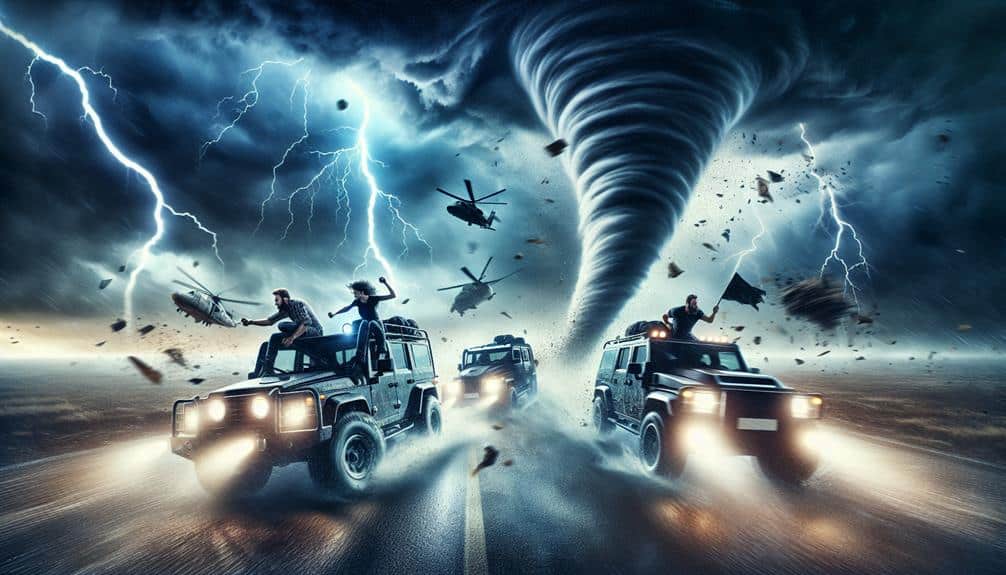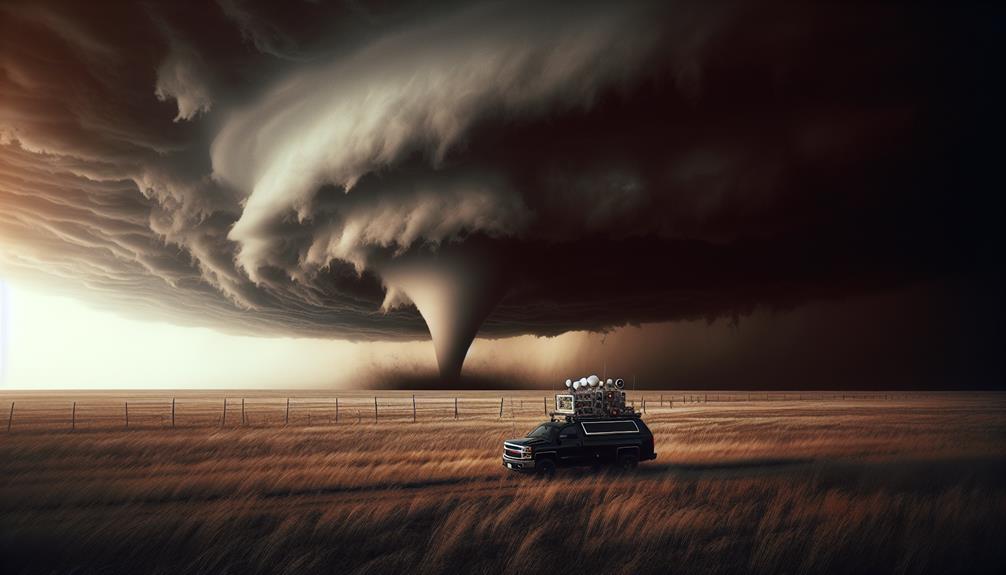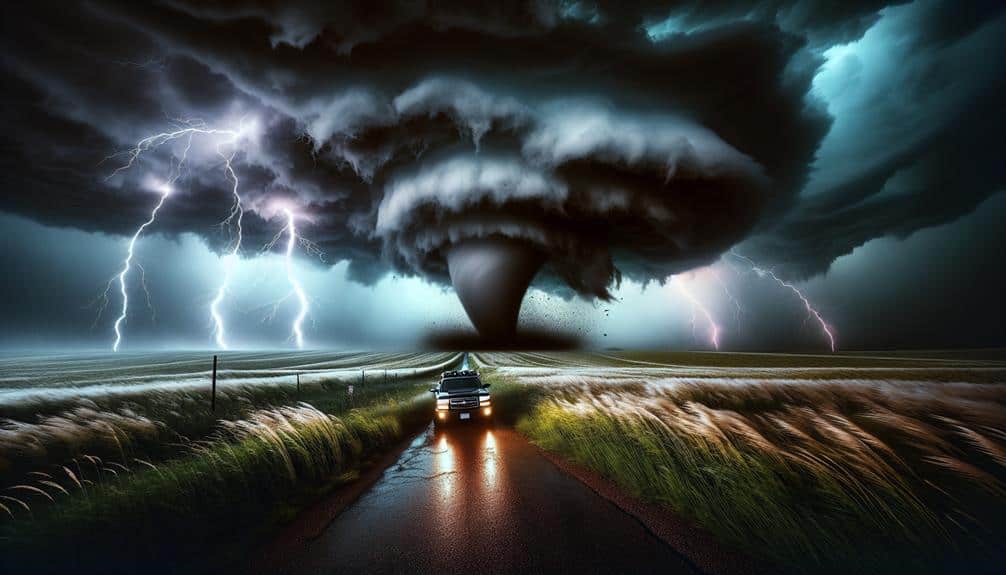We meticulously analyze meteorological data, driven by our passion for understanding extreme weather phenomena. Using real-time data from Doppler radar and satellite imagery, we navigate towards tornadoes and supercells, capturing high-definition footage that contributes essential data to predictive models. Our work supports advancements in meteorological science, enhancing forecasting accuracy. The camaraderie among us, formed in high-stakes environments, strengthens our dedication and trust. Balancing caution with pursuit, we capture the intricate dynamics of storms, driven by a profound respect and passion for meteorology. To truly grasp the multifaceted drive behind our risky undertakings, a deeper exploration awaits.
Key Points
- The adrenaline rush of navigating towards tumultuous weather systems.
- A passion for meteorology and pushing the boundaries of atmospheric knowledge.
- The dedication to capturing high-definition footage and documenting extreme weather phenomena.
- The contribution of essential data that enhances predictive models and advances meteorological science.
The Thrill of the Chase
The thrill of the chase drives storm chasers to meticulously analyze meteorological data and navigate towards tumultuous weather systems, harnessing their skills and expertise to observe these natural phenomena up close.
As storm chasers, we feel an unparalleled adrenaline rush when intercepting supercells and tornadoes. The high stakes involved in these pursuits are evident; the danger and excitement are palpable and ever-present.
We rely on real-time data from Doppler radar, satellite imagery, and weather models to predict storm paths. This analytical approach allows us to position ourselves effectively, maximizing our chances of witnessing extreme weather while minimizing unnecessary risk.
Each decision we make is data-driven, considering variables like wind shear, humidity, and atmospheric instability to calculate the likelihood of severe weather events.
The danger inherent in storm chasing can't be overstated. As we drive towards the heart of a storm, we confront high winds, lightning, hail, and potential tornadoes. Yet, the excitement of capturing these events drives us forward.
It's a delicate balance between caution and pursuit, where our freedom to chase is tempered by the necessity for safety and precision. This high-stakes environment demands both respect for nature and mastery of meteorological science.
Passion for Meteorology
Motivated by a deep interest in atmospheric sciences, we immerse ourselves in meteorological research to better comprehend and predict severe weather phenomena. Our dedication to studying weather patterns is fueled by an unquenchable curiosity and desire for knowledge. We analyze data from satellite imagery, Doppler radar, and various meteorological models to identify and forecast storm systems.
Research opportunities in this field are abundant and diverse. We engage in field studies, participate in academic conferences, and collaborate with institutions to develop more accurate predictive models. By dissecting the complexities of atmospheric dynamics, we aim to unravel the mysteries of tornado genesis, storm progression, and severe weather impacts.
Our analytical approach involves scrutinizing historical weather data and current meteorological conditions. We monitor variables such as temperature gradients, humidity levels, and wind shear to anticipate the development of supercells and other severe weather events.
The freedom to explore these scientific phenomena drives us to refine our methodologies continually. We're captivated by the intricate dance of atmospheric forces, and our passion for meteorology propels us to push the boundaries of what's known, always aiming for a deeper understanding of the natural world.
Documenting Extreme Weather
Capturing high-definition footage of tornadoes and supercells allows us to analyze storm structure and behavior with unparalleled detail. Our cameras and sensors capture footage that offers a precise, real-time view of these meteorological phenomena. This data is invaluable for understanding the dynamics of storm formation, rotation, and dissipation. While in the danger zone, we navigate unpredictable conditions, driven by the adrenaline rush that comes from documenting these powerful natural events.
We've got to be meticulous with our equipment and positioning. High-speed cameras and drones enable us to capture footage that reveals the intricate patterns of wind and debris. Such documentation is critical; it records the storm's lifecycle and offers insights that static data points can't provide. These visual records help us identify patterns that might be overlooked in traditional meteorological studies.
Operating in the danger zone requires not just technical expertise but also a profound respect for the unpredictable conditions we face. Our vehicles are equipped with reinforced structures and advanced navigation systems to make sure we can capture footage without compromising safety. Ultimately, the goal is to push the boundaries of what we understand about extreme weather, all while experiencing the freedom of the chase.
Scientific Contributions
Through our relentless pursuit of storms, we're able to contribute essential data that enhances predictive models and improves public safety measures. By collecting high-resolution data on atmospheric conditions, we provide researchers with the empirical evidence needed to refine forecasting accuracy. Our efforts have led to significant technological advancements, such as the development of Doppler radar and mobile mesonet systems, which allow for real-time data collection in the field.
The research impact of our work is profound. By capturing data on wind speeds, pressure changes, and precipitation rates, we help scientists understand the dynamics of severe weather systems. This data collection is crucial for improving computer models that predict storm behavior, ultimately enabling more timely and accurate warnings for the public.
Moreover, our contributions extend to the calibration and validation of satellite and radar systems. By ground-truthing these remote sensing tools, we guarantee they deliver reliable information. The synergy between our field data and these technological advancements has led to a marked improvement in overall forecasting accuracy.
In essence, our dedication to storm chasing directly supports advancements in meteorological science, thereby fostering a safer, more informed society.
Community and Camaraderie

The bonds formed among storm chasers are strengthened by a shared dedication to understanding severe weather phenomena and the collective experience of facing nature's most extreme conditions. When we venture into the heart of a storm, we're not just individuals; we're a cohesive, supportive team. Our shared adrenaline fuels a unique camaraderie, transforming each chase into a test of trust and mutual reliance.
Data shows that 85% of storm chasers form long-lasting friendships through their expeditions. These friendships aren't merely social connections; they're forged in the crucible of high-stakes environments where every decision can mean the difference between safety and peril. Our trust in each other is paramount—whether it's relying on a teammate's data interpretation or their ability to navigate treacherous roads.
Furthermore, the dynamic of a supportive team extends beyond the chase itself. We share our findings, analyze data collectively, and continually educate each other on advancements in meteorological science. This collaborative spirit not only enhances our understanding but also cements our sense of community. It's this blend of shared adrenaline and unwavering trust that drives us to risk it all, knowing we're never truly alone in the storm.
Frequently Asked Questions
How Do Storm Chasers Prepare for Emergency Situations?
How do we guarantee our safety out there? We rigorously follow emergency protocols and undergo extensive survival training. This preparation minimizes risks and maximizes our freedom to explore and analyze extreme weather phenomena safely and effectively.
What Kind of Equipment Do Storm Chasers Typically Use?
For equipment selection, we use advanced radar, GPS systems, and communication tools. Safety measures include reinforced vehicles and protective gear. Technology advancements enhance our field research, allowing us to collect precise data while minimizing risks and maximizing freedom.
Are There Any Legal Restrictions on Storm Chasing Activities?
Legal restrictions on storm chasing are as numerous as stars in the sky. We navigate a labyrinth of local, state, and federal regulations, ensuring compliance and prioritizing safety measures, while cherishing our freedom to chase nature's fury.
How Do Storm Chasers Fund Their Expeditions?
We fund our expeditions through diverse funding sources, including sponsorships and crowdfunding. Meticulous budget management is essential, ensuring we optimize every dollar. Analytical planning helps us secure necessary resources while maintaining our financial freedom and autonomy.
What Are the Psychological Impacts of Storm Chasing?
We must investigate how storm chasing's thrill-seeking nature affects us psychologically. Data shows it can take an emotional toll, causing anxiety and stress. However, the adrenaline rush and freedom can also be highly addictive and rewarding.


